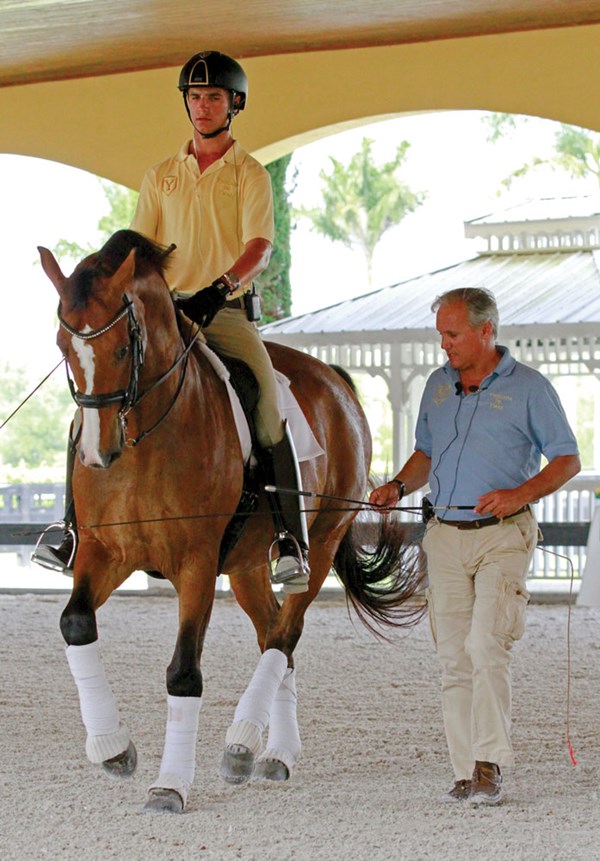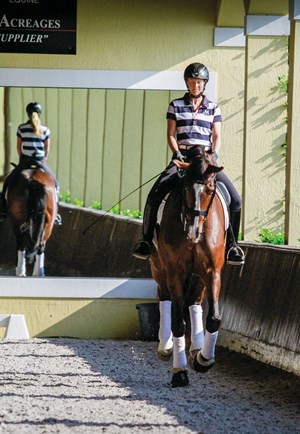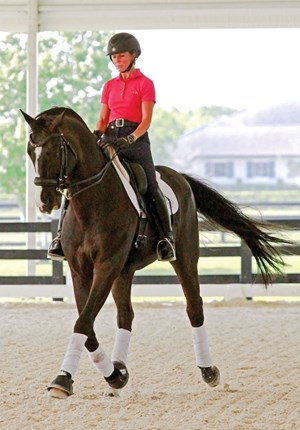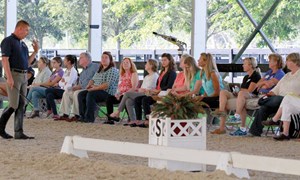
A summer highlight for The Dressage Foundation (TDF) is its International Dream Program that sends four top Young Riders to Europe, all expenses paid, with two chaperones who are leaders in the sport. All six participants soak up what they can from visits to some of Europe’s finest dressage trainers such as Klaus Balkenhol, Hubertus Schmidt, Jean Bemelmans, Ingrid Klimke, Kyra Kyrklund, Carl Hester, Charlotte DuJardin, Laura Bechtolsheimer-Tomlinson and more. Many of TDF’s young “Dreamers” have emerged as leaders in the sport.
At the end of this year’s Florida season, on March 23, a fundraiser in support of TDF and its program for Young Riders invited participants of all ages to a Florida version of the International Dream Program. Numerous top competitors and trainers in the sport welcomed TDF supporters to an up-close-and-personal experience at some of Florida’s top dressage farms.
First Stop: Stillpoint Farm

Owned by Arlene “Tuny” Page, Stillpoint Farm is known as a haven for top professionals from all over the world who hone their exceptional skills in a positive, supportive atmosphere. Tuny represented the U.S. in the 2006 World Cup and at the 2007 Aachen Horse Show. For the TDF group, she rode her own 12-year-old Dutch gelding, Woodstock, with six-time Canadian Olympian Christilot Boylen doing the commentary. Christilot discussed half halts and how the rider works within them to make the horse more adjustable. “The rider is constantly monitoring and managing for the basics of suppleness and straightness,” she said. “These half halts need to work perfectly before the horse can do smooth transitions.”
Tuny demonstrated beautiful, easy strides of very collected canter, which Christilot referred to as “crunches” that make the horse strong enough in his weight-carrying ability to do full pirouettes. Christilot rode her own young Grand Prix horse while talking about the basics of rider position and the effect of the aids. “It’s all about two legs and two reins to keep the horse straight,” she said. She discussed longitudinal and lateral suppling, underlining the importance of strengthening the basics as the horse works through the levels.
During this visit, Dr. Wilfried Bechtolsheimer, or “Dr. B,” the father of British Olympian Laura Bechtolsheimer-Tomlinson, talked about the importance of rhythm and relaxation as he coached his student, Lara Griffith. Lara was working on forward-and-back transitions to help her horse become more responsive. Lara did just two half steps and then went forward in collected trot. She repeated the transitions many times, and it looked easy. “In a few weeks,” said Dr. B, “you can do three half steps and then four at a time. Then it’s easy to do more and more because the horse understands and has gotten stronger.” He spoke of shoulder-in as the “mother of dressage, because if you have the diagonal inside-leg-to-outside-rein connection, you can do anything.”
His daughter, Laura, entered the arena with a beautiful mare, and Dr. B told us that horses should dictate the pace of the training. He referred, once again, to the importance of rhythm and relaxation and said, “With this mare, we could get the rhythm, but it wasn’t always relaxed, so her training took longer. It wasn’t a question of whether her performance would be good, but rather of when it would be good,” he said. Laura stretched the mare frequently, and Dr. B was quick to tell the group that she wasn’t demonstrating rollkur, which he said is “the wrong way.”
One of the horses made a mistake twice, and he recommended a break. “Be sure the muscles are relaxed with proper blood supply,” Dr. B said. “If a horse makes a mistake, 80 percent of the time he didn’t understand the rider’s message. Riders and trainers should have the attitude of a kindergarten teacher who is kind, patient and always wondering ‘how can I make the learning easier?’”
To that end, at home in England, their horses work in the morning and then each horse always has another activity in the afternoon. They either go on a hack, for a canter on the track, work on the longe or in the aqua trainer.
On the bus between stops on the tour, trainer Lendon Gray, ever the educator, stimulated thinking. “Notice that all these riders are looking up,” she said. “It doesn’t take a fancy horse or an expensive trainer to look ahead! Notice their attention to transitions.”
Second Stop: Scott and Susanne Hassler and Michael Klimke

Harmony Sport Horses is all about partnerships with people as well as with horses. The home base, owned by Leslie and John Malone, is in Kiowa, Colorado. Scott and Susanne Hassler are based in Chesapeake Bay, Maryland, as well as Wellington, Florida, and Michael Klimke trains his dressage horses in Munster, Germany. This great partnership works so well because of their common training philosophy. Scott spoke about it as his wife, Susanne, rode an elegant Grand Prix schoolmaster and Michael rode his successful 10-year-old Hanoverian gelding, Fineliner. The primary focus of Harmony Sport Horses is the well-being of the horse, and as Scott spoke, he revealed the depths of his understanding of each horse.
“Good training is a lot about reading the horse,” he explained. “Susanne’s horse thinks the world is full of ghosts. He needs a confident rider who will coach him kindly. When a horse has confidence, he wants to try harder for us, and our job is to build his confidence.”
“Horses don’t resist,” he continued, “but they are sometimes confused or out of balance. Listen to your horse. In riding, a two-way street is the best way. If your horse is shying, then he’s not on the aids. Learn to ride and train your horse better. It’s our job to figure out what our horses need.”
Scott thinks like a horse. He explained that riders think of the movements as defined requirements, but he noted that for the horse, “each movement is a sensation.” As such, the rider needs to give the horse the right feeling.
He underscored the horse’s need for many walk breaks to rejuvenate him mentally and physically. “You want his concentration and then relaxation,” he said. “If you don’t have that relaxation, you can’t have power. Young horses especially, get tired in the mind and in the back, and for that reason, the walk is often tight after the canter. The all-important gaits are improved when the fundamentals are solid.
Susanne encouraged auditors to watch good riding. “You no longer have to be in Europe to see great riding,” she said. She recommended ClipMyHorse.de,
a website that features top European riders competing.
Third stop: Juan Matute at Elemis Ranch

Cristina Danguillecourt and Javier Bacariza, owners of Elemis Ranch and Yeguada de Ymas, met us warmly and ushered us into their covered school, where Juan Matute guided Young Riders who were working their horses in hand. His son, Juan Jr., and another student worked an 8-year-old Hanoverian and a Spanish stallion, respectively, in hand. “The training of Iberian horses is exactly the same as that of others,” said Juan. First, they do walk–halt transitions, then circles, shoulder-in, renvers and half pass, all from the ground. The elegant Hanoverian is from jumping lines and was purchased for $10,000 as a 3-year-old. They have built him into a wonderful athlete, which is the satisfying part for them. They are obviously passionate about developing their horses to achieve their potential. “We create the body, and he learns how to use himself,” said Juan.
Although the horses sometimes offered piaffe, their riders were careful not to overcollect them because it produces too much tension unless the horse is supple. In hand, they played by moving each horse’s body without the rider. The fact that it was Monday meant that it was a day to have fun. Some of the horses were very playful, and Juan said, “we accept it—to a point!” He is adamant that the horses know the medium walk. “Then,” he said, “we can control the walk.” They used very little whip. Rather, they used the voice and half halts. “Half halts produce the power, not the whip,” said Juan. The whip is to be used without aggression.
Juan Jr. rode after the work in hand, and his father suggested that he use the whip lightly on the top of the croup, and the horse used his entire body very expressively. The play continued as Juan Jr. rose to the trot that became passage. “Always playing,” commented his father. “It’s not difficult to train tricks, but the mind is difficult to train.”
Juan, himself, worked a young stallion in hand, and the horse was very feisty. “This is all about relationships,” he said. “We work eye to eye, and for that reason I never recommend working with sunglasses on. The 5-year-old is like a teenager,” he said. “He needs to learn that I am alpha, but we want to create horses that are happy to work.” Juan thinks jumpers are happier than dressage horses, who can feel claustrophobic with riders who are too often perfectionists. He recommended that his riders go to a half seat. “This is another thing we can take from the jumpers,” he said. “We often ride them in the grass and let them express their personalities. Also they gallop on the big track to develop big gaits.”
In addition to his passion for training dressage horses, Juan loves teaching young riders and wishes that more will join him.
Final Stop: Roundabout Stables
Our last stop found us at Roundabout Stables, owned by Pat Stempel, where Shelly Francis rode Danilo, an 11-year-old gelding owned by Pat. Shelly was going to compete Danilo the following day, so she did her normal routine for the day before a show.
She was a bit worried that the audience would be bored. “I don’t do anything earth-shattering,” Shelly said. “It just takes time for them to learn and get strong.” She walked Danilo for some time and then began lateral work in the walk. “I get him a little supple before we begin trot or canter,” she said. As a result, Danilo’s trot was beautifully rhythmic and balanced from the beginning. The work looked easy and Shelly’s manner was relaxed and confident.
Like our other hosts, Shelly is concerned about keeping her horses happy. She schools them three or four days a week, and they do something fun the other days. After her warm-up trot, she did easy working canter with Danilo and then haunches-in and shoulder-fore in canter. Then she did canter on the spot until the horse got his balance and could carry comfortably. She commented that she was reminding him to stay in front of the leg.
Danilo did transitions between collected trot and passage and then did the same routine in short steps of trot, staying in them until he was steady and confident. Shelly commented that physically Danilo could have done the Grand Prix a year ago, but she wanted to wait a year until he was more confident and mentally developed.
At the end of the day, the bus made its way through dressage farmland, where there was a dressage arena in nearly every front yard, and back to the Global facility. Jenny Johnson, TDF’s executive director, thanked those who flew from as far as California for joining the tour and supporting TDF. Thanks also go to Taylor Harris Insurance Services for sponsoring lunch.
This year’s International Dream Program will send four Young Riders and two chaperones to the 2015 European Championships, held at Aachen in August. Next year, TDF’s Florida Dream Tour, open to all, will be two days in March.











